Here’s an 20 science project model ideas tailored for 10th-grade students:
1.Working Model of a Wind Turbine

A wind turbine is like a big, tall fan with three long, narrow blades. When the wind blows, it makes the blades spin around. This spinning motion is what we call “rotating.”
Now, imagine this: when the blades rotate, they turn a special part inside the turbine called a generator. Think of the generator like a magic box that can turn the movement of the blades into something we can use – electricity!
Inside the generator, there are coils of wire and magnets. When the blades turn the generator, the magnets make the electrons in the wire move. These moving electrons create electrical energy, which is what powers our homes and gadgets.
The electricity made by the wind turbine then travels through wires to our homes, schools, and businesses, so we can use it to light up rooms, charge our phones, and do many other things.
So, in simple words, a wind turbine catches the wind, turns it into spinning, and this spinning makes electricity. It’s like turning wind power into super useful energy!
2.Solar Water Heater Model
Imagine a solar water heater as a special box on your rooftop that uses the power of sunlight to make warm water for your home.

Here’s how it works:
- Sunlight Absorption: The box has a dark surface that loves to soak up sunlight. When the sun shines on it, this surface gets really hot.
- Trapping Heat: Inside the box, there are tubes or pipes filled with water. This hot surface transfers its heat to the water in the tubes. It’s like how a hot pan heats up the water you put in it.
- Circulating Warm Water: As the water gets warm, it naturally rises up and flows into a tank or a storage unit. This is where the warm water is stored until you need it.
- Using the Warm Water: When you turn on a faucet to wash your hands or take a shower, the warm water from the storage unit flows out and you can use it.
The best part is, this process doesn’t use any electricity or gas. It’s all powered by the sun! So, on sunny days, you get lots of warm water without spending extra money on energy.
It’s like having a magic box that turns sunlight into nice, warm water for your home!
3.Hydroponic System for Plant Growth
Imagine a hydroponic system like a special way of growing plants without using soil. Instead, the plants grow in water!

Here’s how it works:
- Water with Nutrients: In this system, plants are placed in a tray or container with water. But this water isn’t just regular water; it’s full of special nutrients that plants need to grow big and healthy.
- Roots in the Water: The plants’ roots dangle down into this nutrient-rich water. They soak up the nutrients just like they would from soil.
- Support and Stability: To keep the plants stable, they might be placed in something like little baskets or cups, or they may have a special structure to hold them up.
- Lights for Growth: Hydroponic systems often have special lights that mimic sunlight. This helps the plants to photosynthesize, which is how they turn light into energy.
- Water Circulation: The water doesn’t just sit still. It’s usually on a cycle, flowing around the roots, which ensures the plants get a constant supply of nutrients.
This system is really efficient because it gives the plants exactly what they need, right when they need it. It’s like a high-tech way of growing plants, and it’s used in places where soil might not be the best option, like in cities or areas with poor soil quality.
So, it’s like a special water garden where the plants get all their food and drink delivered right to them!
4.Model of a Simple Electric Motor
Imagine a simple electric motor as a tiny, magical machine that can make things spin. Here’s how it works:
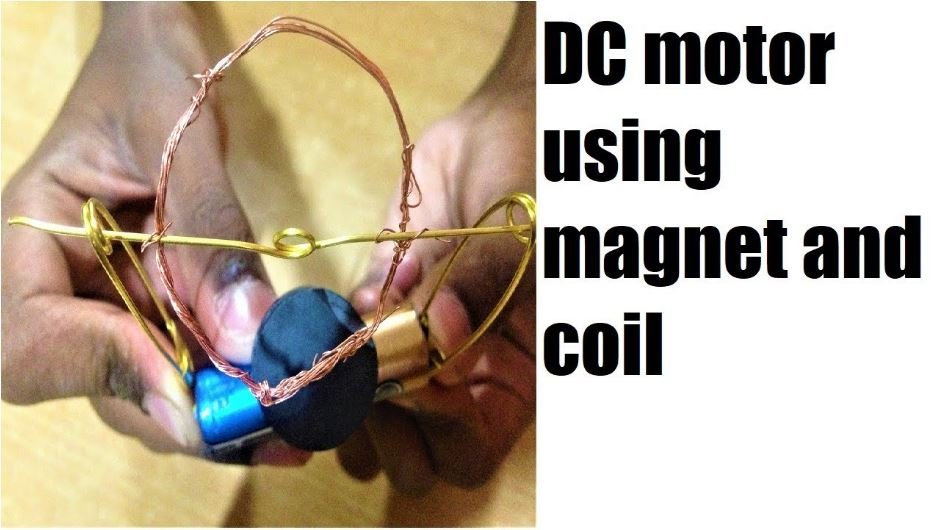
- Magnet Magic: Inside the motor, there’s a special kind of magnet. This magnet has a north pole (imagine it like the top of a hill) and a south pole (like the bottom of a hill).
- Coil of Wire: There’s also a coil of wire. A coil is like a spring, but flat. It’s made of metal, like a paperclip, but it’s bent into a loop. This loop of wire sits on a rod, and it can spin around.
- Electric Trickery: When we send electricity through this wire, something amazing happens. The coil of wire starts to act like a magnet too! If the north pole of the coil becomes a magnet, it will either attract or repel the magnet inside the motor.
- Spinning Begins: Because magnets like to either push away from each other or pull towards each other, this makes the coil start to spin. It’s like magic!
- Keep It Going: But here’s the really cool part – the spinning coil is connected to a little switch. This switch helps the electric current switch directions, which means the coil keeps spinning. It’s like giving it a gentle push every time it slows down.
So, in simple words, an electric motor is like a little spinning wizard! It uses magnets, electricity, and some clever tricks to make things move. That’s why we see electric motors in things like fans, toys, and even cars! They’re the secret behind lots of things that move.
5.Working Model of a Hydroelectric Power Plant
A hydroelectric power plant is like a giant water wheel that uses the power of flowing water to make electricity. Here’s how it works:

- Water Flow: Imagine a big river with lots of water flowing downstream. This is like a super big, natural water slide!
- Dam Magic: Near the river, there’s a big wall called a dam. The dam stops the water from flowing freely and makes it back up, creating a huge reservoir, like a giant pool.
- Release the Water: When we need electricity, we open up special gates in the dam. This lets some water flow out.
- Water Turns a Wheel: As the water rushes out, it hits a set of big blades, kind of like the blades on a fan. This makes the blades spin around.
- Generator Magic: Now, remember those spinning blades? They’re connected to something called a generator. Inside the generator, there are magnets and wires that work together like magic to create electricity. It’s like turning the movement of the blades into electric power!
- Sending Electricity: The electricity made in the generator travels through wires to our homes, schools, and businesses. That’s where we use it to light up rooms, power our gadgets, and do many other things.
And that’s it! So, in simple words, a hydroelectric power plant uses the power of flowing water to make electricity. It’s like turning the river’s energy into super useful energy for all of us to use!
6.Model of a Greenhouse
Think of a greenhouse as a special house for plants. It’s a bit like a sunny, cozy home where plants can grow happily. Here’s how it works:

- Lots of Windows: A greenhouse is made mostly of glass or clear plastic. This is so sunlight can come in easily. Sunlight is like superfood for plants – they need it to grow!
- Trapping Heat: When sunlight enters the greenhouse, it gets trapped inside. It’s like when you wear a jacket on a sunny day – you stay warm because the jacket keeps the heat from escaping.
- Warm and Cozy: The trapped sunlight warms up the air and soil inside the greenhouse. This creates a nice, warm environment for the plants, even if it’s cold outside.
- Protecting from Weather: The walls and roof of the greenhouse also protect the plants from harsh weather like strong winds, heavy rain, or too much direct sunlight.
- Good for Different Plants: Because it’s like a cozy home, you can grow all sorts of plants in a greenhouse. It’s great for flowers, vegetables, and even some fruits!
- Growing All Year: Because the greenhouse keeps things warm, you can grow plants even in the winter when it’s too cold outside for them.
So, in simple words, a greenhouse is like a special house where plants get lots of sunlight and warmth. It’s like a little paradise for them, helping them grow strong and healthy!
7.Demonstration of Electromagnetic Induction
Electromagnetic induction is like a magical way of making electricity by using magnets and moving them around. Let’s break it down in simple terms:
- The Magic of Magnets: Imagine you have a strong magnet, and you have a coil of wire. When you move the magnet close to the coil, something amazing happens.
- The Dance Begins: The magnet’s presence makes something incredible happen inside the wire. It’s like the wire wakes up and starts to have a little dance party with the magnet.
- The Electric Trick: This dance creates something called an electric current. Think of it like a flow of tiny, invisible particles called electrons. This flow of electrons is what we call electricity!
- Moving the Magnet: If you move the magnet away from the wire, or bring it closer, the dance gets faster or slower. This changes the amount of electricity flowing in the wire.
So, in simple words, electromagnetic induction is like a dance party between magnets and wire. When they dance together, they create electricity! This is used in lots of things we use every day, like generating electricity in power plants. It’s a bit like turning magic into power for our homes and gadgets!
8.Model of a Water Filtration System
A water filtration system is like a super-cleaner for water. It helps take out all the stuff we don’t want to drink. Here’s how it works:
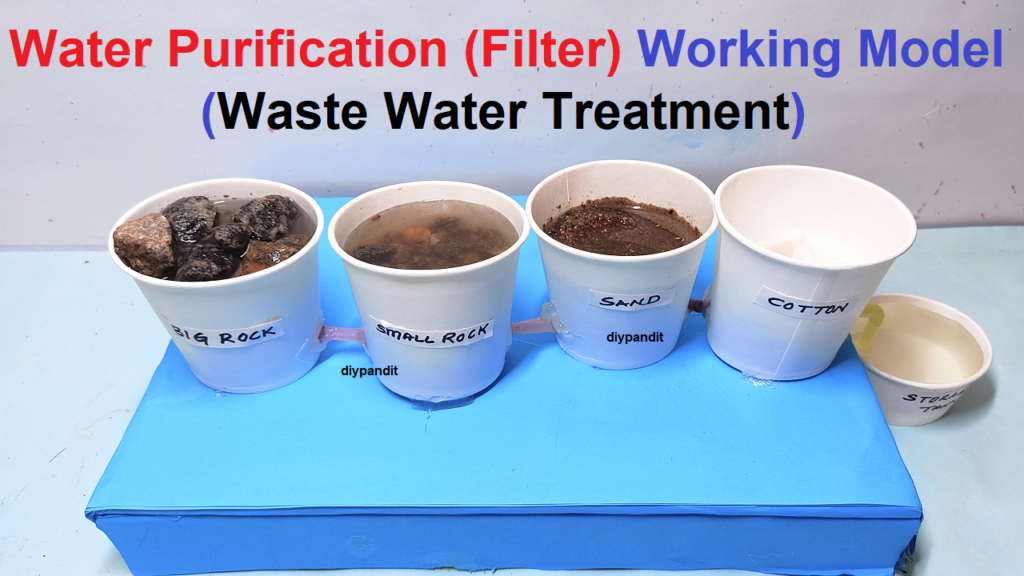
- Dirty Water In: First, we pour water into the filtration system. This water might have things like dirt, tiny particles, or even germs that we don’t want to drink.
- Different Layers: Inside the system, there are different layers of special materials, like sand, gravel, and sometimes even charcoal. These layers are like layers of a sandwich.
- Filtering Magic: As the water passes through these layers, the tiny particles and impurities get trapped. It’s like when you try to pass a big ball through a net with small holes – the ball gets stuck, but smaller things can go through.
- Clean Water Out: After going through all these layers, the water that comes out is much cleaner and safer to drink. It’s like the system gives the water a good bath!
- Goodbye Germs: Sometimes, there are even special parts in the system that use chemicals or ultraviolet light to kill germs and make sure the water is really safe.
- Ready to Drink: Now, the water is ready for us to drink or use for cooking and cleaning. It’s much better for our health.
So, in simple words, a water filtration system is like a super-cleaning machine for water. It takes out all the yucky stuff and gives us nice, clean water to drink! It’s like having a mini water spa for our tap water!
9.Working Model of a Geothermal Energy Source
A geothermal energy source is like a hidden treasure of warmth and power beneath the Earth’s surface. Let’s understand it in simple terms:

- Underground Heat: Deep within the Earth, there’s a lot of heat. This heat comes from the super-hot center of our planet, where it’s like a giant, fiery furnace.
- Hot Water and Steam: Sometimes, this underground heat warms up water and turns it into steam. It’s like when you heat a pot of water on the stove, and it starts to turn into steam.
- Bringing it Up: In a geothermal energy system, we drill a hole into the Earth to reach this hot water and steam. We bring it up to the surface.
- Turning a Turbine: When the hot water and steam reach the surface, they’re really powerful. They can be used to turn a special machine called a turbine. It’s like a big fan that spins around really fast.
- Creating Electricity: This spinning turbine is connected to a generator, which works like a magic box. It turns the spinning motion into electricity. It’s the same way a bicycle dynamo turns your pedaling into light for your bike!
- Using the Electricity: The electricity made by the generator goes into wires and travels to our homes, schools, and businesses. It’s what powers our lights, appliances, and gadgets.
So, in simple words, a geothermal energy source is like a natural hot spring deep underground that gives us warm water and steam. We use this power to make electricity, and it’s a bit like having a secret energy source right beneath our feet!
10.Demonstration of Newton’s Laws of Motion
Newton’s Laws of Motion are like a set of rules that describe how things move. Let’s break them down in simple terms:

Newton First Law – Inertia:
Imagine you’re in a car that suddenly stops. You feel like you’re being pushed forward, right? That’s because your body wants to keep moving, just like the car was moving.
Newton’s first law says that things like to keep doing what they’re doing – if they’re moving, they want to keep moving, and if they’re still, they want to stay still. We call this “inertia.”
Second Law – Push and Weight:
If you try to push a heavy box, it’s harder than pushing a light one, right?
Newton’s second law explains this. It says that the harder you push, and the heavier something is, the faster it will go. So, to move something big, you need to give it a strong push!
Newton Third Law – Action and Reaction
Imagine you’re on roller skates and you push off a wall. You move away from the wall, right? But did you know the wall moves a teeny-tiny bit too?
It’s just a very, very tiny movement because it’s so much heavier than you.
Newton’s third law says that for every action (like your push), there’s an equal and opposite reaction (the tiny push the wall gives you).
Imagine playing with a big bouncy ball. When you throw it against the ground, it bounces back up! That’s Newton’s third law in action. The ball pushes on the ground, and the ground pushes back, making the ball bounce.
So, in simple words, Newton’s Laws of Motion are like a set of rules that explain how things move and interact with each other. They help us understand why cars stop when we brake, why it’s harder to push heavy things, and even why balloons fly when we let them go! They’re like the secrets of how our world moves!
11.Model of a Rainwater Harvesting System
A rainwater harvesting system is like a magical way to collect rainwater and use it for all sorts of things.
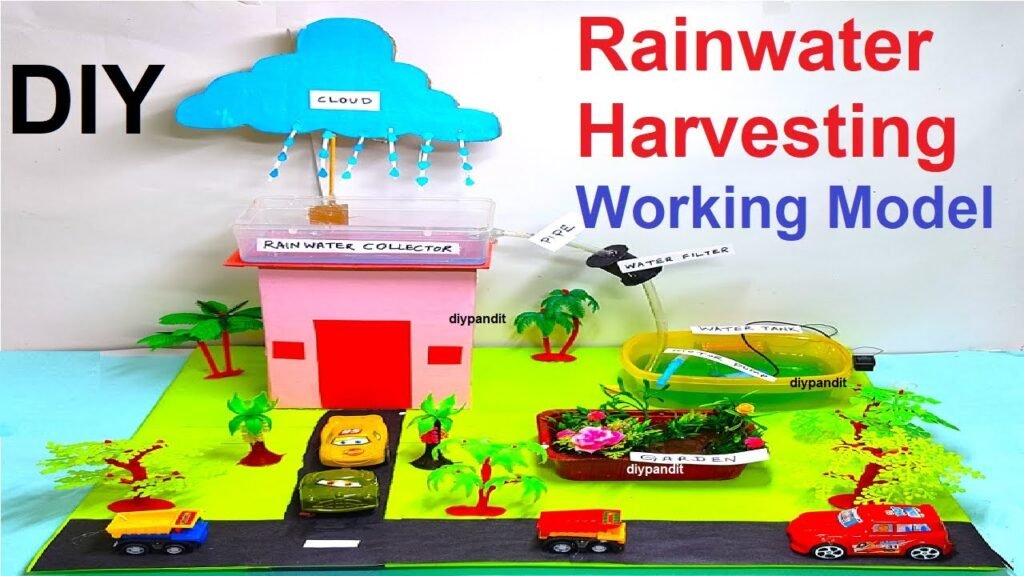
Let’s understand it in simple terms:
- Rain’s Gift: When it rains, water falls from the sky. This is like a free gift from nature!
- Collecting Rainwater: Imagine having a big, clean bucket. When it rains, you put the bucket out to collect the rain. That’s what a rainwater harvesting system does, but on a bigger scale.
- Roof Magic: The roof of a building acts like a giant umbrella. When it rains, the roof catches all the raindrops and directs them down into a pipe.
- Filters and Gutters: Before the rainwater goes into the storage tank, it passes through filters. These filters catch any leaves or dirt to keep the water clean. Then, special gutters guide the water into the storage tank.
- Water Storage: The storage tank is like a big, clean container that holds all the collected rainwater. It’s usually underground or in a special tank near the house.
- Using the Rainwater: Later, when we need water for things like watering plants, flushing toilets, or even for washing, we can use this stored rainwater. It’s like having a secret stash of water!
- Saving Water Bills: By using the rainwater we’ve collected, we don’t need to use as much from the tap. This can help save money on water bills.
So, in simple words, a rainwater harvesting system is like a smart way to save the rain and use it for different things around our homes. It’s like catching raindrops in a big, special bucket and using them whenever we need them!
12.Working Model of a Steam Engine
A steam engine is like a powerful, old-fashioned machine that uses steam to do big tasks.
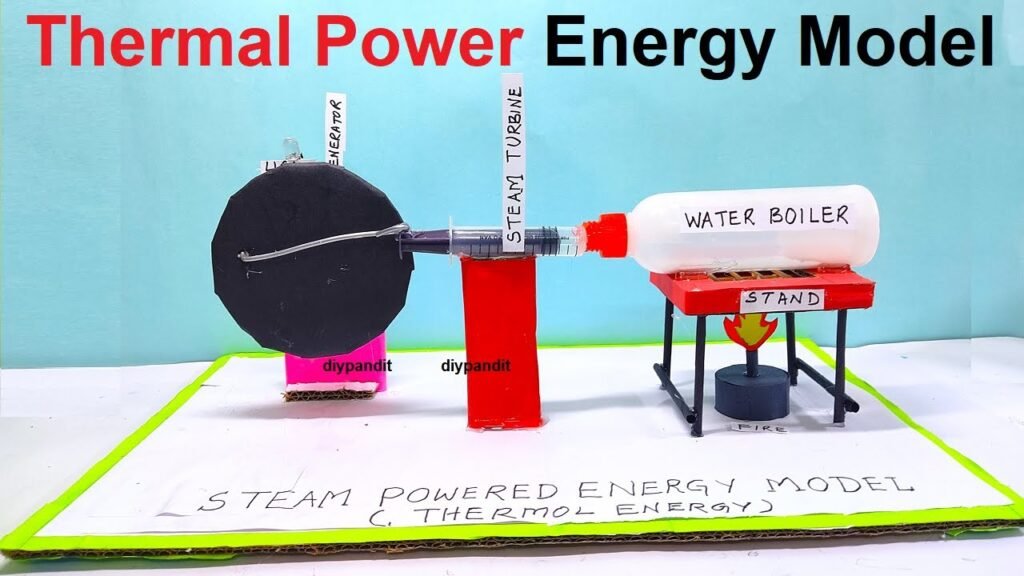
Let’s break it down in simple terms:
- Boiling Water: Imagine you have a pot of water on the stove. When you heat it up, it starts to turn into steam. This steam is like super-hot, invisible water vapor.
- Steam Power: In a steam engine, we have a special chamber called a boiler. Inside, we heat up water until it turns into steam. This steam has a lot of energy, like a bunch of very bouncy balls.
- Pushing a Piston: The steam is let into a big cylinder, which is like a tube with a tight-fitting plunger inside. When the steam rushes in, it pushes this plunger (called a piston) with a lot of force. It’s like a strong push!
- Turning a Wheel: Now, this powerful push makes the piston move back and forth. This motion is used to turn a big wheel, like a giant, metal bicycle wheel.
- Generating Power: The turning wheel is connected to a generator. Just like in a bicycle dynamo, this generator takes the motion from the wheel and turns it into electricity!
- Using the Electricity: The electricity generated can be sent through wires to power lights, machines, and other devices. It’s like having a mini power plant!
So, in simple words, a steam engine is like a strong, steam-powered worker. It takes the energy from boiling water, turns it into powerful pushes, and uses them to generate electricity. It’s a bit like turning hot water into a big, spinning generator!
13.Working Model of the Human Digestive System
A working model of the human digestive system is like a mini-replica of how our body processes food.

Let’s break it down in simple terms:
- Mouth – Chewing Station: Imagine this is where you start eating. You put food in your mouth, chew it up, and mix it with saliva. This is like a little food factory in your mouth!
- Esophagus – The Slide: When you swallow, the food goes down a tube called the esophagus. It’s like a slide that takes the food from your mouth to your stomach.
- Stomach – The Mixer: In your stomach, the food gets mixed up with special juices. These juices help break down the food into tiny pieces. It’s like a big mixing bowl!
- Small Intestine – The Absorption Place: After the stomach, the food goes into the small intestine. Here, the tiny pieces of food are absorbed into your body. It’s like taking the good parts out of a smoothie!
- Large Intestine – The Cleaner: What’s left after the small intestine is mostly water and waste. The large intestine soaks up the water, making the waste more solid. It’s like a sponge that cleans up!
- Rectum and Anus – The Exit: Finally, the waste gets stored in the rectum until your body is ready to get rid of it. When you go to the bathroom, it’s like your body saying, “Okay, time to go!”
This model helps us understand how our body takes in food, processes it, and gets rid of what it doesn’t need. It’s like a little factory inside us, working to keep us healthy and strong!
14.Working Model of a Tidal Power Generator
A tidal power generator is like a big underwater windmill that uses the power of ocean tides to make electricity.
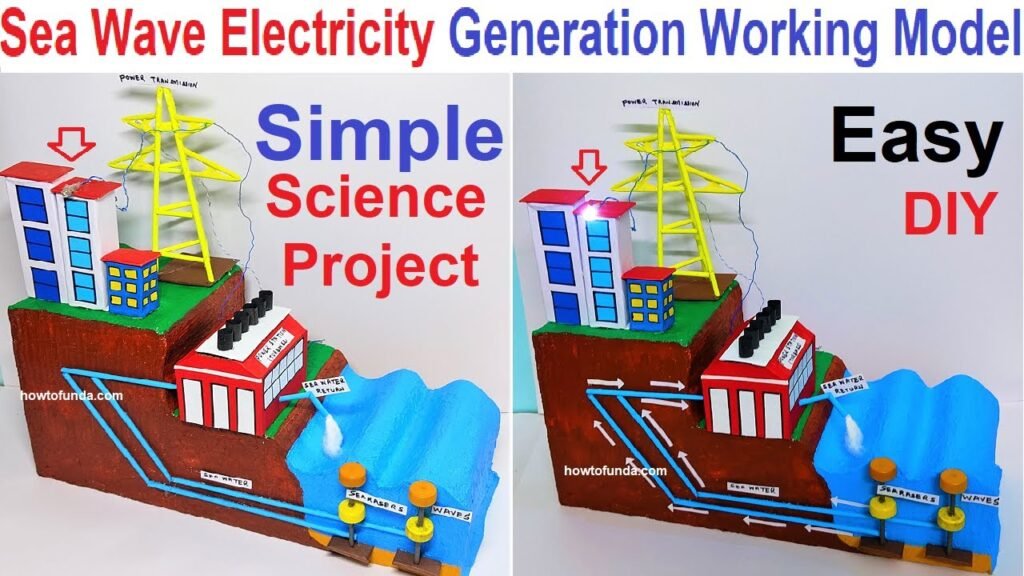
Let’s break it down in simple terms:
- The Mighty Tides: You know how the ocean has big waves that go in and out? These are caused by the pull of the moon and the sun. This movement of water is called a tide.
- Underwater Windmill: Now, imagine there’s a big, special machine placed underwater. It has blades, just like a windmill, but they’re under the water.
- Capturing the Tide: When the tide comes in or goes out, it makes the water flow past the blades of the underwater windmill. This flow of water is like a push, and it makes the blades spin around.
- Turning Motion into Electricity: Connected to the blades is a generator. This magical machine takes the spinning motion of the blades and turns it into electricity. It’s like turning the energy of the tide into power!
- Sending Electricity to Homes: The electricity made by the generator travels through wires to our homes, schools, and businesses. That’s where we use it to light up rooms, power our gadgets, and do many other things.
And that’s it! So, in simple words, a tidal power generator is like an underwater windmill that uses the power of ocean tides to make electricity. It’s like capturing the energy of the moving ocean water and turning it into useful power for us!
15.Working Model of a Nuclear Power Plant
A nuclear power plant is like a super high-tech boiler that uses a special kind of energy to make electricity.

Let’s break it down in simple terms:
- Tiny Building Blocks: Inside the power plant, there are teeny-tiny particles called atoms. These atoms are like the building blocks of everything around us.
- Splitting the Atoms: In the power plant, they use a special trick called nuclear fission. It’s like splitting an atom into smaller pieces. This creates a lot of heat!
- Heat, Steam, and Spin: The heat from the splitting atoms is used to make water really, really hot. This hot water turns into steam, just like when you boil water for tea. The steam is super powerful.
- Turning the Turbine: This powerful steam is directed at a turbine, which is like a big fan that spins around really, really fast.
- Making Electricity: The spinning turbine is connected to a generator. This magic box takes the spinning motion and turns it into electricity, just like in a bike dynamo.
- Sending Electricity to Homes: The electricity made by the generator travels through wires to our homes, schools, and businesses. That’s where we use it to light up rooms, power our gadgets, and do many other things.
And that’s it! So, in simple words, a nuclear power plant is like a super-hot, high-tech boiler. It uses the energy from teeny-tiny atoms to create steam, which turns a big fan and makes electricity. It’s like turning atomic energy into useful power for all of us!
16. Working Model of the Human Respiratory System
A working model of the human respiratory system is like a demonstration that shows how we breathe and get oxygen into our bodies.

Let’s break it down in simple terms:
- Breathing In: Imagine you’re taking a deep breath. You breathe in through your nose or mouth. The air you breathe in carries oxygen, which is like the fuel our bodies need to work.
- Trachea – The Windpipe: When you breathe in, the air goes down your throat and into a tube called the trachea. It’s like a pathway for air.
- Lungs – The Oxygen Tanks: At the end of the trachea, it splits into two smaller tubes called bronchi. These lead to your lungs. Your lungs are like big, squishy balloons where the oxygen goes.
- Bronchioles – Tiny Tubes: Inside your lungs, the bronchi split into even smaller tubes called bronchioles. They’re like tiny highways that take the air deep into your lungs.
- Alveoli – The Oxygen Exchange: At the end of the bronchioles, there are tiny air sacs called alveoli. These are like little pockets where oxygen goes into your blood, and carbon dioxide (a waste gas) comes out.
- Bloodstream – The Oxygen Transport: Now, the oxygen gets into your bloodstream. It hitches a ride on special cells called red blood cells. These cells carry the oxygen all over your body, giving energy to your muscles and organs.
- Breathing Out: After your body uses the oxygen, it makes carbon dioxide as waste. This carbon dioxide needs to go out. So, you breathe out, and it goes back through the same pathway.
So, in simple words, the human respiratory system is like a clever transportation system for oxygen. It brings in the oxygen we need and takes away the waste gases. It’s how we get the energy to run and play!
16.Working Model of a Simple Pendulum
Imagine you have a long string with a weight (like a small ball) attached to the end. You hold the string and let the weight hang down.
- Starting the Swing: If you pull the weight to one side and let it go, it starts to swing back and forth. This back-and-forth motion is what we call a pendulum.
- Gravity at Work: When you let go, gravity pulls the weight downward. This makes it swing to the other side. Then, gravity pulls it back again, and the swinging continues.
- The Regular Beat: The pendulum swings back and forth at a steady, even pace. This is because of the force of gravity acting on it.
- The Changing Height: Notice that the weight doesn’t swing as high on each side. This is because some of the energy of the swing is turned into motion, and it gradually slows down.
- The Never-Ending Swing: In a perfect world with no air resistance, a pendulum would keep swinging forever! But in the real world, things like air resistance slow it down over time.
So, in simple words, a simple pendulum is like a swinging game with a weight on a string. It goes back and forth because of gravity, and it helps us see how things move regularly. It’s like a natural clock, swinging steadily!
17. Working Model of the Human Circulatory System
A working model of the human circulatory system is like a fun demonstration that shows how our heart pumps blood around our body.
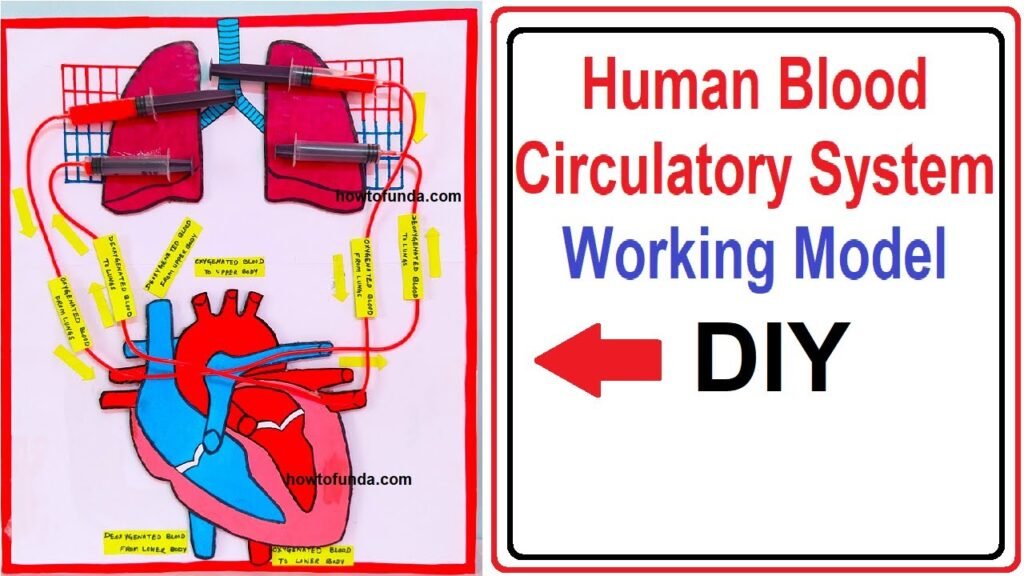
Let’s break it down in simple terms:
- The Heart – The Pump: Imagine your heart as a powerful pump, like the one you might use to fill up a bike tire. It’s a special muscle that pushes blood around our body.
- Arteries – The Highways: From the heart, blood flows out through arteries. These are like the highways that carry blood away from the heart to all parts of our body.
- Capillaries – The Tiny Streets: Arteries lead to tiny, narrow streets called capillaries. These are so small that only one blood cell can pass through at a time. It’s like a little road that connects every part of your body.
- Veins – The Return Trip: After the blood has delivered oxygen and nutrients to our body’s cells, it needs to return to the heart. Veins are like the roads that carry blood back to the heart.
- Lungs – The Oxygen Factory: Blood travels to the lungs, where it gets a fresh supply of oxygen. This is like stopping at a factory to refill a delivery truck.
- Back to the Heart: Now, the oxygen-rich blood returns to the heart, ready to be pumped out again.
- The Cycle Continues: This process keeps repeating, over and over again, keeping our bodies supplied with the oxygen and nutrients they need.
So, in simple words, the human circulatory system is like a big transportation network. The heart is the pump that sends blood out through arteries, which lead to tiny capillaries. After dropping off oxygen and nutrients, the blood returns through veins, then goes to the lungs to get more oxygen. It’s like a big delivery service, making sure every part of our body gets what it needs to work properly!
18.Working Model of Pascal’s Law
A working model of Pascal’s Law is like a hands-on demonstration that shows how pressure works in fluids.

Let’s break it down in simple terms:
- Balloon Squeeze: Imagine you have a balloon filled with water. When you squeeze one side of the balloon, the water inside gets pushed to the other side. This is because when you apply pressure in one area, it affects the whole fluid.
- Syringe Example: Think about a syringe at a doctor’s office. When the doctor pushes the plunger, the medicine inside is forced out of the needle. This happens because the pressure applied to the plunger is transmitted through the fluid inside.
- Pascal’s Law Principle: Pascal’s Law says that when you apply pressure to a confined fluid, it transmits that pressure equally in all directions. It’s like a magic rule that makes fluids behave in a certain way.
- Hydraulic System: In big machines, like car lifts or bulldozers, they use hydraulic systems. These systems use Pascal’s Law to lift heavy objects. When you push on a small piston (like in a syringe), it transmits the pressure to a larger piston, allowing it to lift something heavy.
- Leaky Balloon Demonstration: You can do a fun experiment with a water-filled balloon. If you press a pin into one side of the balloon, the water squirts out from the other side. This is because the pressure you applied in one spot is transmitted through the water to the other side.
So, in simple words, Pascal’s Law is like a special rule for fluids. It says that when you push on a fluid in one place, that push gets spread out everywhere. This idea is used in all sorts of machines and systems, making them work efficiently! It’s like a secret of how liquids behave under pressure.
19.Working Model of a Biogas Plant
A working model of a biogas plant is like a small, hands-on version of a system that turns waste into useful energy.

Let’s break it down in simple terms:
- What Goes In: Imagine you have a mixture of kitchen waste (like leftover food) and animal dung. This mixture is what goes into a biogas plant.
- The Digester – The Magic Tank: Inside the biogas plant, there’s a big tank called a digester. It’s like a special stomach for the waste. This tank is airtight, so no air can get in.
- Bacteria at Work: There are special bacteria in the digester that love to eat the waste. As they eat, they produce biogas as a byproduct.
- Biogas – The Energy Gas: Biogas is like a mixture of gases, mainly methane. It’s what we can use as a source of energy.
- Gas Holder – The Storage: Above the digester, there’s a floating cover called a gas holder. It collects the biogas and stores it. When the gas is produced, it pushes up the gas holder.
- Using the Biogas: When you need energy for cooking or lighting, you can connect a pipe to the gas holder. The biogas flows through the pipe and you can use it, just like using gas from a cylinder.
- Slurry – The Plant Food: After the bacteria finish digesting the waste, what’s left is a nutrient-rich liquid called slurry. This is like superfood for plants!
- Fertilizer for Plants: You can use the slurry as fertilizer for your garden. It’s great for helping plants grow strong and healthy.
So, in simple words, a biogas plant is like a magic box that turns kitchen waste and animal dung into a gas we can use for energy. It also gives us a special liquid that helps our plants grow. It’s like turning waste into a useful resource!
20.Working Model of a Rain Gauge
A working model of a rain gauge is like a special tool that helps us measure how much rain has fallen.
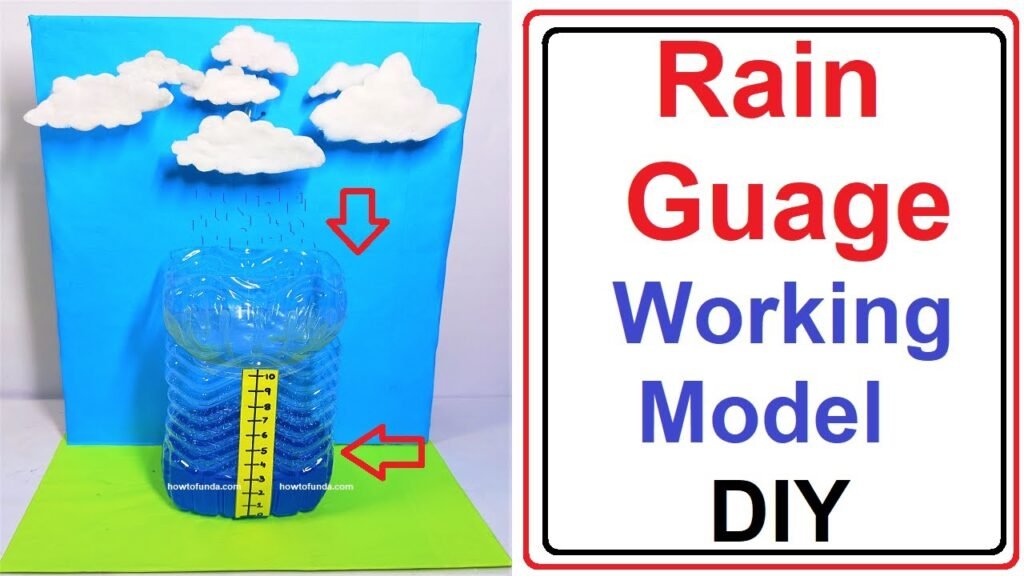
Let’s break it down in simple terms:
- The Collector – Like a Funnel: Imagine a small container with an open top, like a funnel. This is the part of the rain gauge that collects the rain.
- The Scale – Like a Ruler: Inside the container, there’s a ruler-like scale. This scale helps us see how much rain has collected.
- Checking the Rain: When it rains, the water falls into the open top of the container. It collects in the bottom, just like how water collects in a cup when it rains.
- Reading the Measurement: After the rain, you can look at the scale inside the container. The number where the water level reaches tells you how much rain fell.
- Recording the Data: You can note down the measurement, like “1 inch of rain” or “2 centimeters of rain.” This helps us keep track of how much rain we’ve had.
So, in simple words, a rain gauge is like a special container with a ruler inside. When it rains, it collects the water, and we can see how much rain there was by looking at the ruler. It’s like a rain-measuring tool that helps us keep track of the weather!

